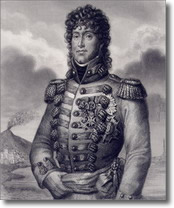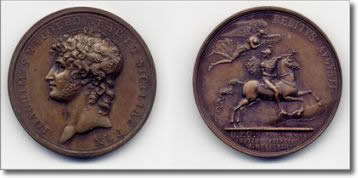
- Gioacchino Murat, King of Naples, print from an engraving on copper, 19th Century
On 1st August 1808, Napoleon put the intrepid Gioacchino Murat on the throne of Naples; the brother-in-law of Giuseppe Bonaparte, Napoleon's brother who was destined to inherit the throne of Spain, succeeded him.
Murat blazed his way to power and fame; at the age of 40 he was Commander of the imperial cavalry: From being the son of the owner of a modest hotel in south-west France he bacme the Marshal of the Empire, Grand Duke of Berg and then King of Naples. His undoubted military qualities had acquired added value thanks to his marriage in 1800 to Carolina Bonaparte, Napoleon's sister.
Murat's relationship with the French king was one of hate-love.he shared the emperor's craving for power bu, though forever grateful for his investiture asking, when Napoleon's star began to fade, he went as far as to get rid of pacts and sentiments in order to keep the crown. Caroline had the same ambition, but with a difference - she regarded her reign as a point of arrival, whereas for Gioacchino it was only the beginning.
In 1812 Napoleon decided to egin his military campaign against Russia and Murat was the Commander of the imperial cavalry. He was valorous in action; the first to enter Moscow, he was given general command of the troops for the tragic retreat.
When he perceived the political decline of Napoleon, his sole objective was to retain the kingdom. In January 1813 he abandoned the command of the Armée and hurried back to Naples, where he arrived at 9 pm on 4 February.
The rumour was made to circulate that his hurried return was due to "the bad state of his health", but a few days later the street buzz was that "Napoleon was disgusted with Gioacchino for his act of desertion".
The programme of the festivities included three evenings of city lights and the municipal authorities, "Joyful at his happy return to the People after the glorious fatigues of war", decided to have a medal coined to celebrate the event.
